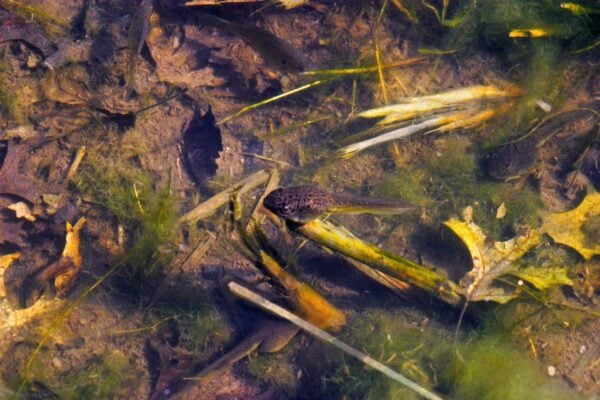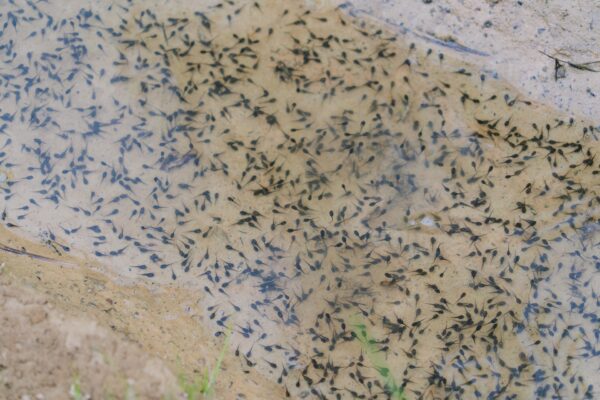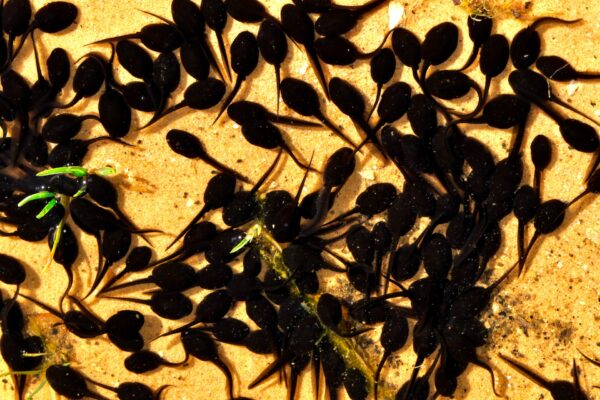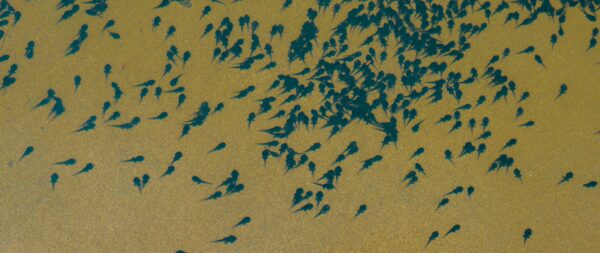Tadpoles aren’t exclusive to frogs. Salamanders, toads, and other amphibians also hatch tadpoles. They’re the larvae stage of these amphibians that hatch in the water and eventually undergo metamorphosis to become adult animals.
Tadpoles aren’t considered pets, but their developed forms certainly are. As an aquarist, you may be interested in hatching and caring for tadpoles to grow them into exotic frogs, toads, and salamanders.

In this article, we’ll discuss the best tadpole diets, caring tips, and where to find them.
Table of Contents
What do Tadpoles Eat in Nature?
Tadpoles hatch in freshwater ponds, puddles, and streams. Most tadpole species go through herbivorous to carnivorous diet stages while deriving nutrition from plants, organic matter, insects, and microorganisms.
Initially, they live off the egg mass and start feeding on algae, aquatic plants, and decaying plant material in the water. Their specially designed oral disk (which vary in size and shape from species to species) helps them scrape algae and plankton to suck up.
Their need for protein and other nutrients grows significantly to prepare their body for metamorphosis. Therefore, during the intermediate stages, they embrace an omnivorous diet of plant matter, small aquatic insects, invertebrates, and crustaceans.
In the later stages, when metamorphosing and “rearranging organs”, they shift towards a completely carnivorous diet by actively hunting larger prey, aquatic animals, and even other tadpoles.
However, you need to offer your acquired tadpoles an appropriate diet, depending on their development stage, until they’ve reached froghood.
Plant-Based Tadpole Food
Early-stage tadpoles are herbivores and require carbohydrates, vitamins, and minerals delivered to them. Up to 6 weeks, you can rely on the veggies found in your kitchen to feed these bumpy creatures.
During their herbivorous stages, tadpoles develop serrated jaws and teeth-like mouthparts. These adaptations help them grasp, scrape, and ingest their food. But, they aren’t sufficient enough to chew on the fibrous veggies like lettuce and spinach.
We recommend boiling the leafy vegetables to make them more digestible to the tadpoles. Here are a few options that you should consider:
1. Lettuce
Blanch or boil the leaves and give the tadpoles romaine lettuce for vitamins and minerals. If you choose to boil, cool them down in icy water to break down the cellulose layer.
2. Cucumbers
Remove the skin and cut the cucumbers into small pieces to make them float. You may also boil them. Cucumbers are great for vitamins, antioxidants, and minerals.
3. Carrots
Cut the carrots into thin slices and allow them to thaw before introducing them to your tadpoles. Boil them if the slices are too thick. Carrots are a rich source of vitamin A.
4. Broccoli
Feed broccolis in small quantities to tadpoles. Boil and cool them beforehand before introducing them to the tank.
5. Algae and Algae Wafers
Being a large portion of the tadpole diet in the wild, fresh algae can be pretty sustainable for them. In case fresh algae isn’t derivable, commercially available algae wafers can be a good replacement.
6. Aquatic Plants
Some aquatic plants can be fed to tadpoles which have been acquired from an outdoor pond. It’s not advised to feed wild aquatic plants like milfoil and pondweed to pet tadpoles as they can contaminate your tank.
7. Spirulina Powder
Spirulina is a blue-green algae used as a dietary supplement for aquatic animals, including tadpoles. Sprinkle small amounts into the tadpole habitat and see them gobbling it.
Whatever diet you may offer, don’t make your pet tadpoles (From pet stores and breeders) feed on outdoor food sources.
Also Read: Proserpinaca Palustris Care Guide.
Protein-Based Tadpole Food
Once your tadpoles are 6 weeks or up, they develop limbs and lungs. Introduce sloping rocks and slanted shelves to allow them to climb up partially. Since the tadpoles will soon begin to jump, your aquarium should always be covered by a strong lid.

Introduce protein-rich food into their diet slowly during this time. As they start to grow limbs and develop more complex structures like lungs and small intestines, they need more protein and nutrients. Meanwhile, they may also start to scrap the veggies in favor of a protein-based diet.
A few protein-based foods suitable for tadpoles of 6 to 9 weeks are:
1. Commercial Amphibian Food
Commercially available amphibian food, available online and in pet stores, are specially designed nutritional alternatives of natural protein for frogs and tadpoles in later stages. These are typically rich in protein and other essential nutrients. Commercial foods strive to support the growth and development of the tadpoles.
2. Brine Shrimp
Brian shrimps can take over the diet of highly carnivorous tadpole species, such as Green frog and American Bullfrog tadpoles. But, for omnivorous tadpoles, it can be a great fulfilling weekly treat.
3. Bloodworms
If you already have fish tanks, live or dried bloodworms should already be accessible. They’re bright-red larvae of midge flies. They’re commercially available.
Feed them on a regular interval to your tadpoles for better development.
4. Daphnia
Daphnias are small, translucent crustaceans commonly known as “water flies”. They often grow in the tank or can be sourced from pet stores. These can provide the essential proteins for your tadpoles.
5. Fish Food
Flakes and pellets made for aquarium fish can be crushed and fed to tadpoles if amphibian food is unavailable. But unless they are made high-protein, they don’t sustain the tadpoles’ long-term requirements.
6. Boiled Egg Yolk
Hard-boiled egg yolk, broken into pieces, can be offered as a source of protein. However, sparingly feed it to avoid water pollution.
Example of Tadpole Species by Diet
Here are a few common tadpoles that you may find in your local pet store or outdoor pond. Refer to the USGS Field Guide to Amphibian Larvae or USGS Tadpole Guide for further research.

1. Herbivorous Tadpoles
- American Toad (Bufo americanus):
- Diet: Herbivorous, primarily consuming algae and aquatic plants.
- Adaptations: Flat, rounded mouths for efficient grazing.
- Preferred Food: Algae, diatoms, aquatic plants, and decaying plant material.
- Appearance: They have a streamlined, cylindrical body with a round oral disc designed for scraping algae.
- Wood Frog (Lithobates sylvaticus):
- Diet: Herbivorous. Feeds on algae and plant material.
- Adaptations: Specialized mouthparts for scraping algae.
- Preferred Food: Algae, aquatic plants, and detritus.
- Appearance: They are typically small with a relatively plain coloration. Often brown or gray.
2. Omnivorous Tadpoles
- Bullfrog (Lithobates catesbeianus):
- Diet: Omnivorous. Consumes both plant and animal matter.
- Adaptations: A broad, V-shaped mouth allows them to capture a variety of prey.
- Preferred Food: Insects, crustaceans, small fish, tadpoles, algae, and aquatic plants.
- Appearance: Bullfrog tadpoles are among the largest tadpoles. They have a distinct dark coloration and large eyes.
- Green Frog (Lithobates clamitans):
- Diet: Omnivorous. Prefer animal prey.
- Adaptations: Prominent eyes and a wide mouth for catching prey.
- Preferred Food: Insects, small aquatic invertebrates, tadpoles of other species, algae, and aquatic plants.
- Appearance: They have a greenish-brown body with a distinctive ridge running along the sides.
3. Carnivorous Tadpoles
- Budgett’s Frog (Paraguay Horned Frog, Lepidobatrachus laevis):
- Diet: Highly carnivorous. Known for consuming other tadpoles.
- Adaptations: Large mouth, powerful jaws, and a voracious appetite.
- Preferred Food: Other tadpoles, small aquatic invertebrates, and insects.
- Appearance: They have a flattened, round body and a distinctive mouth that gives them a “grinning” appearance.
Leptodactylus Species (e.g., Paraguay Caatinga Frog):
- Diet: Some species have carnivorous tadpoles.
- Adaptations: Specialized mouthparts for capturing prey.
- Preferred Food: Insects, small aquatic invertebrates, and tadpoles of other species.
- Appearance: Varies among species but often includes camouflage patterns and streamlined bodies.
4. Filter-Feeding Tadpoles
- African Clawed Frog (Xenopus laevis):
- Diet: Filter feeders. Captures small particles from the water column.
- Adaptations: Fringed mouthparts and modified gill arches for filter-feeding.
- Preferred Food: Algae, bacteria, protozoans, and small organic particles suspended in the water.
- Appearance: They have a streamlined body with fully webbed feet and fringed gills on the sides of their head.
Also Read: Musk Turtle Care Guide.
Tadpole Cannibalistic behavior
As mentioned, tadpoles can indulge in cannibalistic behaviors. But they don’t usually engage other tadpoles unless they are starving and are fighting for space. However, some species of tadpoles also (probably mistakenly) attack and eat smaller tadpoles.
In artificial waters, these occurrences are pretty rare.
Some researchers also argue that feeding on their own species is the most nutritional diet possible for tadpoles. The nutrients required for survival will ideally and accurately be available in the meat of their species. But, brine shrimps were found to be much more nutritious for tadpoles than tadpole meat.
However, cannibalism also presents issues like retaliation and the rapid spread of illness.
What to not Feed Tadpoles?
In addition to obvious items, certain foods are unsuitable for your pet tadpoles. Here are some of them with associated reasons.
1. Fruits
Complex fruits like apples, bananas, oranges shouldn’t be fed to your tadpoles. Their digestive system isn’t designed to break down and absorb complex carbs and cellulose. However, as mentioned, boiled cucumbers are acceptable.
2. Bread and Breadcrumbs
Bread and breadcrumbs lack protein and any other nutrients required for tadpole growth. They’ll be full but malnourished. Moreover, bread may also contain preservatives and other additives.
3. Terrestrial Grass
Tadpoles aren’t designed to eat terrestrial grass (land grass). Both their mouthparts and digestive system are incapable of processing terrestrial grass. But they can eat aquatic plants and algae.
4. Canned Food
Canned food, both veggies and meat, may contain preservatives, salt, and artificial flavoring. It’s advisable to not include canned food in your tadpoles’ diet.
5. Non-Insect Meat
Don’t provide your tadpoles with beef, chicken, or any other non-insect meat in any form. Their digestive system isn’t tolerant enough to digest those complex proteins.
6. Dog and Cat Food
Due to similar reasons, dog and cat food are unsuitable as amphibian food. Feeding dog pellets can cause digestive issues and may prove to be fatal for your tadpoles.
7. Processed Food
Any processed food, including hot dogs, shouldn’t be fed to tadpoles or adult frogs. At the 9-week mark, they can eat live insects and smaller fish.
How to Feed Tadpoles?

As a tadpole parent, your responsibility lies in properly feeding your tadpole in appropriate proportions and frequency. If your tadpoles aren’t sourced from the wild, you need to be extra careful about their well-being by avoiding overfeeding, malnourishment, and pathogens.
Up to 6 Weeks
- Amount of Food: For 100 tadpoles, half a cup (around 4 fl oz. or 120 ml) of food should be enough. However, see if they’re still hungry and slowly increase the amount to find the sweet spot. Remove any uneaten food.
- Diet: Frozen or boiled veggies, including broccoli, spinach, lettuce, and all other things that we mentioned.
- Feeding Process: Feed them once per day and spread the food around the tank or pond. Use a spoon to periodically drop the food into the tank.
- Feeding Time: 30 minutes. Drop the food into the tank over the period.
6 to 9 Weeks
- Amount of Food: 1 cup of food (240 ml or 8 fl oz.) is a great starting point for growing tadpoles and froglets. Employ a similar strategy and observe if they’re still hungry or wasting food to adjust accordingly.
- Diet: Mentioned veggies, aphids, small fish, ants, mosquitos, and egg yolk.
- Feeding Process: Drop the veggies with a spoon. Feed the insects with tweezers. Drip an egg-yolk-water mix into the tank. Feed them once a day.
- Feeding Time: Slowly drop the food into the habitat over a 20 to 30-minute period.
Also Read: Yellow-Bellied Slider Turtle complete guide.
How to Collect Tadpoles?
Tadpoles are pretty hard to collect but the eggs are pretty visible and easy to harvest. Frogs and other amphibians usually spawn around February and March. If you’re sourcing your tadpoles from a breeder, it’s best to give them a call during this time.
However, if you’re acquiring them from a local pond, look for floating clusters of jelly-like eggs. Collect them in a small amount with the help of a net. You need to maintain a ratio of 15-20 tadpoles per gallon of water.
Prepare a tank beforehand with clean gravel, water, and a slanted platform for the froglets to climb.
Float the eggs in the tank in a plastic bag and make sure to avoid any sudden temperature changes. Open the bag after a few hours so that the spawns are acclimated to the temperature.
Remove any undeveloped eggs and the jelly once they start swimming around the tank. At this point, you need to start feeding them.
Fun Facts About Tadpoles
- Tadpoles are the larvae stage of amphibians, including frogs and toads.
- Most tadpoles feed on a herbivorous diet of plant matter and algae.
- Early tadpoles have gills to breathe underwater. They lose them after metamorphosis.
- Some tadpoles are translucent, allowing you to see their internal organs and see their change more intimately.
- Tadpoles are excellent swimmers.
- Tadpoles are pretty vulnerable to predators such as birds, fish, and insects.
- Tadpoles show cannibalistic behavior when starved.
- Some tadpoles exhibit schooling and shoaling behavior.
- Tadpoles often communicate between themselves with chemical signals.
- Different species of tadpoles have different adaptations to survive in their habitat.
- Some tadpole species exhibit phototaxis abilities. Meaning they can sense light and move towards or away from it.
Tips for Raising Tadpoles in Captivity
- Don’t be overzealous when collecting tadpoles. They’re very fragile and don’t do well in overcrowded tanks.
- Get a sponge filter and air pump that isn’t too powerful.
- Routinely change the water. But not more than one per week.
- Add live plants to your tank that are tadpole-friendly.
- Allow the tadpoles to venture to damp lands when they start growing limbs. Offer soil on all four sides of the tank.
- Once the tadpoles lose their tails and transfer to a baby frog, start providing them springtails and crickets.
- If the mouthparts of the tadpoles are beak-like, they’re probably looking for plant matter as food. Otherwise, they’re omnivorous.
- Do add some cuttlefish bones to their add to promote growth and development.
- Most frogs are horrible as pets and harm themselves by trying to jump over the tank. ID them accurately before keeping the frogs as pets, and do some research.
The Bottom Line
We’ve given you enough information through this article about tadpoles and their feeding behavior to start caring for a few of them. Feed them well, care for them, and you’ll soon see them hopping around happily.
